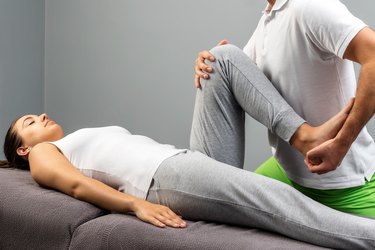
Sciatic nerve flossing is done to improve mobility of the sciatic nerve when it becomes compressed by the muscles and bones — a condition known as sciatica. Nerve flossing exercises can be done at home, but if your symptoms increase, stop and call the doctor.
Read more: Sciatica Exercises to Avoid
Video of the Day
Video of the Day
Recognize Sciatica Symptoms
The sciatic nerve runs from the back of your hips and down your legs. When it becomes trapped and/or inflamed around the lower back and buttocks, it causes sharp pain in the lower back that can shoot down one or both legs, according to the Mayo Clinic.
The most common causes of sciatica are prolonged periods of sitting or standing, which can place pressure on the lower back; a slipped disc in your spine, which then presses against the nerve; or an injury or strain that stretches the nerve.
About Nerve Flossing for Sciatica
The idea behind nerve flossing is that when the sciatic nerve becomes trapped, it grates along the muscles and bones causing scar tissue to build up along the nerve fiber.
This creates a lot of discomfort when you move, as the scarred nerve doesn't glide smoothly and flossing is required to break down the scar tissue — just as flossing your teeth chips away at plaque buildup — to improve mobility.
According to an article published in the January-March 2017 issue of the Indian Journal of Physiotherapy and Occupational Therapy, nerve flossing and other sciatica stretches can help reduce symptoms of sciatica caused by nerve compression in the lower back.
If your symptoms increase while performing neural flossing for sciatica, as demonstrated by the Poole Hospital NHS Foundation Trust, stop immediately and consult a doctor or physical therapist.
1. Seated Sciatic Nerve Flossing
- Sit in a comfortable, but supportive chair, with your back straight and your shoulders down and relaxed.
- Start with your knees bent at 90 degrees and both feet flat on the floor; then slowly straighten the injured leg as you simultaneously tip your neck backward. Only go as far as you can without causing pain; however, it's OK to feel a gentle tugging down the back of your leg.
- Slowly lower your leg back to the starting position and complete 15 leg raises up to five times a day.
Tip
As your symptoms ease, raise your leg and then try pointing and flexing your foot — so your toes point up to the ceiling — to increase the stretch.
2. Sciatic Nerve Flossing: Elevated Leg
- Lie flat on your back with the heel of your injured leg resting on a low table or foot rest.
- Keeping the elevated leg straight, slowly point and flex the foot, making sure your buttocks stay on the floor as you do so.
Tip
The elevated leg should not be so high that it causes pain, nor should you feel any pain during the foot flexion. Repeat as many times as you can and swap sides if you experience symptoms in both legs.
Read more: Is Walking Bad for the Sciatic Nerve?
Follow These Precautions
A compressed sciatic nerve is sensitive and should not be forced or aggravated. So if you feel any pain while doing these exercises — or afterward — you should reduce the elevation of the leg or bend it slightly to ease the tension.
Always avoid stretching your leg through the pain as this will further aggravate the injured nerve. If your pain persists or worsens, you should see a doctor immediately for an accurate diagnosis and tailored treatment plan.